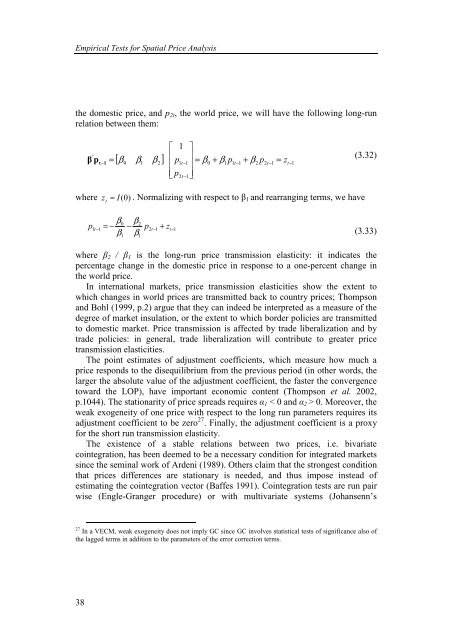TESTING INTERNATIONAL PRICE TRANSMISSION UNDER ...
TESTING INTERNATIONAL PRICE TRANSMISSION UNDER ...
TESTING INTERNATIONAL PRICE TRANSMISSION UNDER ...
Create successful ePaper yourself
Turn your PDF publications into a flip-book with our unique Google optimized e-Paper software.
Empirical Tests for Spatial Price Analysis<br />
the domestic price, and p2t, the world price, we will have the following long-run<br />
relation between them:<br />
38<br />
'<br />
β p<br />
⎡ 1<br />
⎢<br />
⎢<br />
⎢⎣<br />
p<br />
[ β0<br />
β1<br />
β2<br />
] p1t −1<br />
= β0<br />
+ β1<br />
p1t<br />
−1<br />
+ β2<br />
p2t−1<br />
= z −1<br />
t−<br />
1 = t<br />
2t−1<br />
⎤<br />
⎥<br />
⎥<br />
⎥⎦<br />
where zt ≈ I(<br />
0)<br />
. Normalizing with respect to β1 and rearranging terms, we have<br />
p<br />
β<br />
β<br />
0 2<br />
1t− 1 = − − p2t−1<br />
+ zt−1<br />
β1<br />
β1<br />
(3.32)<br />
(3.33)<br />
where β2 / β1 is the long-run price transmission elasticity: it indicates the<br />
percentage change in the domestic price in response to a one-percent change in<br />
the world price.<br />
In international markets, price transmission elasticities show the extent to<br />
which changes in world prices are transmitted back to country prices; Thompson<br />
and Bohl (1999, p.2) argue that they can indeed be interpreted as a measure of the<br />
degree of market insulation, or the extent to which border policies are transmitted<br />
to domestic market. Price transmission is affected by trade liberalization and by<br />
trade policies: in general, trade liberalization will contribute to greater price<br />
transmission elasticities.<br />
The point estimates of adjustment coefficients, which measure how much a<br />
price responds to the disequilibrium from the previous period (in other words, the<br />
larger the absolute value of the adjustment coefficient, the faster the convergence<br />
toward the LOP), have important economic content (Thompson et al. 2002,<br />
p.1044). The stationarity of price spreads requires α1 < 0 and α2 > 0. Moreover, the<br />
weak exogeneity of one price with respect to the long run parameters requires its<br />
adjustment coefficient to be zero 27 . Finally, the adjustment coefficient is a proxy<br />
for the short run transmission elasticity.<br />
The existence of a stable relations between two prices, i.e. bivariate<br />
cointegration, has been deemed to be a necessary condition for integrated markets<br />
since the seminal work of Ardeni (1989). Others claim that the strongest condition<br />
that prices differences are stationary is needed, and thus impose instead of<br />
estimating the cointegration vector (Baffes 1991). Cointegration tests are run pair<br />
wise (Engle-Granger procedure) or with multivariate systems (Johansenn’s<br />
27 In a VECM, weak exogeneity does not imply GC since GC involves statistical tests of significance also of<br />
the lagged terms in addition to the parameters of the error correction terms.
















